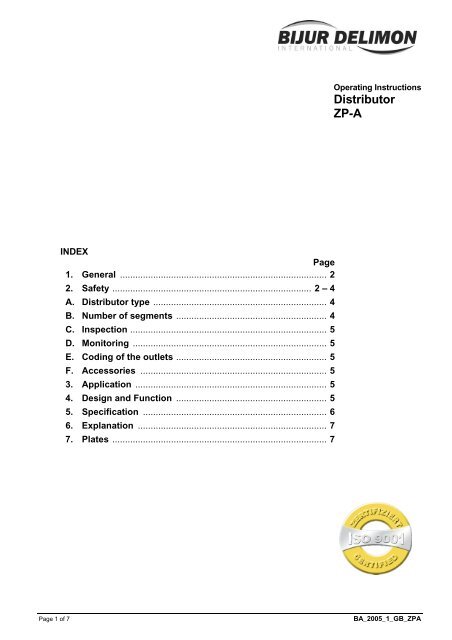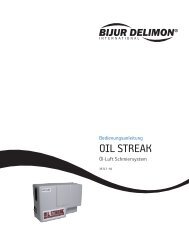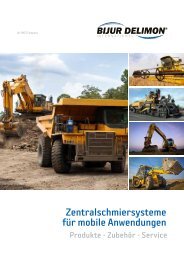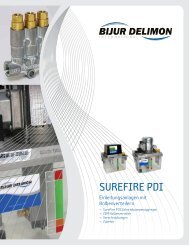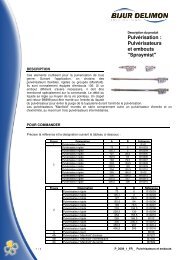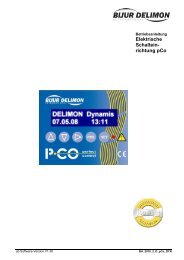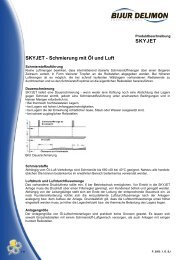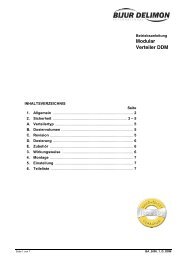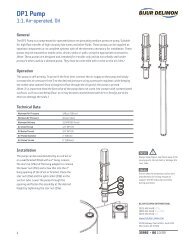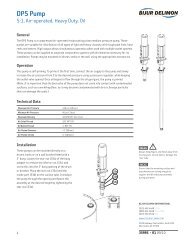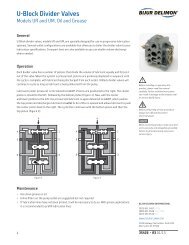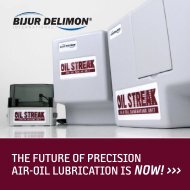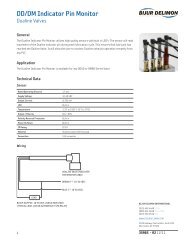Distributor ZP-A - Bijur Delimon
Distributor ZP-A - Bijur Delimon
Distributor ZP-A - Bijur Delimon
You also want an ePaper? Increase the reach of your titles
YUMPU automatically turns print PDFs into web optimized ePapers that Google loves.
INDEX<br />
Page<br />
1. General ................................................................................. 2<br />
2. Safety .............................................................................. 2 – 4<br />
A. <strong>Distributor</strong> type .................................................................... 4<br />
B. Number of segments ........................................................... 4<br />
C. Inspection ............................................................................. 5<br />
D. Monitoring ............................................................................ 5<br />
E. Coding of the outlets ........................................................... 5<br />
F. Accessories ......................................................................... 5<br />
3. Application ........................................................................... 5<br />
4. Design and Function ........................................................... 5<br />
5. Specification ........................................................................ 6<br />
6. Explanation .......................................................................... 7<br />
7. Plates .................................................................................... 7<br />
Operating Instructions<br />
<strong>Distributor</strong><br />
<strong>ZP</strong>-A<br />
Page 1 of 7 BA_2005_1_GB_<strong>ZP</strong>A
1. General<br />
Prior to start up, we recommend to read these operating instructions carefully as we do not assume any<br />
liability for damages and operating troubles which result from the nonobservance of these operating<br />
instructions!<br />
Any use beyond the applications described in these operating instructions is considered to be not in<br />
accordance with the product’s intended purposes. The manufacturer is not to be held responsible for any<br />
damages resulting from this: the user alone bears the corresponding risk.<br />
As to figures and indications in these operating instructions we reserve the right to make technical changes<br />
which might become necessary for improvements.<br />
The copyright on these operating instructions is kept reserved to the company DELIMON. These operating<br />
instructions are intended for the erecting, the operating and supervising personnel. They contain<br />
regulations and drawings of technical nature which must not – completely or partially - be distributed nor<br />
used nor communicated to others without authorization for competition purposes.<br />
Company address, spare parts and service address<br />
DELIMON Branch office<br />
Arminstraße 15 Am Bockwald 4<br />
D-40277 Düsseldorf D-08344 Grünhain-Beierfeld<br />
Phone : +49 211 77 74-0 E-mail : kontakt@bijurdelimon.com<br />
Fax : +49 211 77 74-210 www.bijurdelimon.com<br />
2. Safety<br />
These operating instructions contain fundamental instructions which are to be observed during erection,<br />
operation and maintenance. Therefore it is absolutely necessary for the fitter and the competent qualified<br />
staff/user to read these operating instructions before installation and start-up. The operating instructions<br />
must be available at all times at the place of use of the machine/system.<br />
Not only the general safety instructions stated under this main point “safety“ are to be observed, but also<br />
the other specific safety instructions stated under the other main points.<br />
2.1 Identification of safety warnings in the operating instructions<br />
The safety warnings contained in these operating instructions which, if not observed, may cause dangers<br />
to people, are specially marked with general danger symbols<br />
safety sign according to DIN 4844, warning about a danger spot ,<br />
in case of warning about electric voltage with<br />
safety sign according to DIN 4844, warning about dangerous electric voltage.<br />
In case of safety instructions which, if not observed, may cause damage to the machine and its function,<br />
the word<br />
ATTENTION<br />
is inserted.<br />
Instructions that are directly attached to the machine, as for example<br />
• rotational direction arrow<br />
• identifications for fluid connections<br />
must be observed at all events and maintained in a fully legible condition.<br />
• Note: There is an increased skid risk in case of spilled/leaked out lubricants. They are to be removed<br />
at once properly.<br />
Safety sign according to DIN 4844, warning about skid risk.<br />
Page 2 of 7 BA_2005_1_GB_<strong>ZP</strong>A
2. Safety (continuation)<br />
2.2 Personnel qualification and training<br />
The operating, maintaining, inspecting and erecting personnel must have the appropriate qualification for<br />
such work. Area of responsibility, competence and supervision of the personnel have to be regulated by<br />
the user. If the personnel do not have the necessary knowledge, they have to be trained and given<br />
instructions. This can be effected, if necessary, by the manufacturer/supplier on behalf of the user of the<br />
machine. Furthermore, the user has to make sure that the contents of the operating instructions are fully<br />
understood by the personnel.<br />
2.3 Dangers in case of nonobservance of the safety instructions<br />
The nonobservance of the safety instructions may result in hazards to persons, to the environment and to<br />
the machine. The nonobservance of the safety instructions may lead to the loss of any claims for<br />
damages.<br />
In detail, the nonobservance may for instance lead to the following hazards:<br />
• Failure of important functions of the machine/system<br />
• Failure of prescribed methods for maintenance and repair<br />
• Harzard to persons by electrical, mechanical and chemical influences<br />
• Hazard to the environment by the leakage of dangerous substances<br />
2.4 Safety conscious working<br />
The safety instructions stated in these operating instructions, the existing national regulations as to the<br />
accident preventation as well as possible internal working, operating and safety rules of the user are to<br />
be observed.<br />
2.5 Safety instructions for the user/operator<br />
• If hot or cold machine parts lead to dangers, these parts have to be protected against touch.<br />
• Protection against touch for moving parts (e. g. coupling) must not be removed when the machine is<br />
in operation.<br />
• Leakages (e. g. from the shaft seal) of hazardous goods to be delivered (e. g. explosive, toxic, hot)<br />
are to be removed in such a way that there is no danger to persons and environment. Legal rules<br />
are to be ovserved. .<br />
• Hazards caused by electrial power are to be excluded (for details please refer for instance to the<br />
rules of the VDE and the local power supply companies).<br />
2.6 Safety instructions for maintenance, inspection and installation work<br />
The user has to take care that all the maintenance, inspection and installation work is executed by<br />
authorized and qualified skilled personnel who have informed themselves adequately by thoroughly<br />
studying the operating instructions.<br />
Basically, work on the machine is only to be carried out during shut-down. It is obligatory to observe the<br />
shut-down procedure described in the operating instructions .<br />
Pumps or pump aggregates that deliver media being hazardous to health have to be decontaminated.<br />
Immediately after completion of the work, all safety and protective equipments have to be reinstalled<br />
and/or reactivated.<br />
• Advice: When working with compressed air, do wear glasses.<br />
(DIN 4844 – Use breathing mask)<br />
• Advice: Observe EC-Safety Data Sheet for materials of consumption and additives used and use<br />
personal protective equipment.<br />
(DIN 4844 – Use breathing mask)<br />
Before recommissioning, observe the points stated in section “initial start-up“.<br />
2.7 Unauthorized conversion and manufacture of spare parts<br />
Conversion or modifications to the machine are only permitted when agreed with the manufacturer.<br />
Original spare parts and accessories authorized by the manufacturer serve to ensure safety. The use of<br />
other parts may render the liability for consequencial losses null and void.<br />
Page 3 of 7 BA_2005_1_GB_<strong>ZP</strong>A
2. Safety (continuation)<br />
2.8 Unacceptable modes of operation<br />
The operational reliability of the machine supplied is only guaranteed if the machine is used in<br />
accordance with its intended purposes as per section 1 - General - of the operating instructions. The<br />
limiting values specified in the data sheet must on no account be exceeded.<br />
2.9 Guidelines & standards<br />
1., 2. and 3. guideline (see data sheet: R&N_2009_1_GB)<br />
3.0 Notes on environmental protection and waste disposal<br />
In correct operation with lubricants, the components are subject to the special requirements set by<br />
environmental legislation.<br />
The general requirements for lubricants are specified in the respective safety data sheets.<br />
Used lubricants are hazardous forms of waste and therefore require special supervision in the sense of §<br />
41 paragraph 1 sentence 1 and paragraph 3 no. 1 of KrW-/AbfG (Closed-Loop Waste Management Act).<br />
Used oils must be handled in compliance with AltölV (Waste Oil Ordinance).<br />
The devices or components contaminated with lubricant must be disposed of by a certified waste<br />
management company.<br />
Records of proper waste management must be filed in conformance to NachwV (Ordinance on Waste<br />
Recovery and Disposal Records).<br />
GENERAL PRODUCT CHARACTERISTICS<br />
• Progressive distributor<br />
• up to 24 outlets<br />
• Electronic monitoring possible<br />
• Metered volume: variable from 0.1 cm 3<br />
• Lubricant: grease, fluid grease, oil<br />
A. DISTRIBUTOR TYPE <strong>ZP</strong>A<br />
B. NUMBER OF SEGMENTS<br />
3 segments<br />
4 segments<br />
5 segments<br />
6 segments<br />
7 segments<br />
8 segments<br />
9 segments<br />
10 segments<br />
11 segments<br />
12 segments<br />
Page 4 of 7 BA_2005_1_GB_<strong>ZP</strong>A
C. INSPECTION<br />
Stage A<br />
D. MONITORING<br />
with non-return valve, with motion indicator<br />
with non-return valve, with monitoring switch<br />
E. CODING OF THE OUTLETS<br />
A segment<br />
M segment<br />
E or M segment<br />
F. ACCESSORIES<br />
without<br />
Slot angle<br />
Overpressure indicator 70 or 100 bar<br />
3. Application<br />
The major element of a progressive system is the lubricant distributor.<br />
<strong>Distributor</strong>s <strong>ZP</strong>-A are used to divide and meter lubricant in total loss central lubrication systems (oil, liquid<br />
grease and grease) and in oil recirculation systems suitable for small, medium and large machine plants.<br />
4. Design and function<br />
<strong>ZP</strong>-A distributors consist of several individual segments (at least 3 in the standard version) that are<br />
screwed together and sealed against each other. Depending on the arrangement within the distributor, the<br />
following segment types are available:<br />
• Initial- or A-segment<br />
• Medium or M-segment<br />
• Final- or E-segment<br />
The distributor <strong>ZP</strong>-A has the task to divide the lubricant volume (oil or grease) received under pressure into<br />
portions and to deliver them successively to the up to 24 possible outlets. This is achieved due to pistons<br />
which are moved by the lubricant being under pressure, and forcibly controlled by each other. The pistons<br />
move into their final positions, and the lubricant waiting in front of the piston is successively supplied to the<br />
lubrication points.<br />
The distributor works as long as it is supplied with lubricant.<br />
The distributor is equipped with integrated nonreturn valves. These nonreturn valves, which are integrated<br />
in the distributor outlets, have the advantage that the distributor works reliably even in case of small<br />
lubricant volumes and higher counterpressures involved as far as the line material is flexible.<br />
In case that a visual operational monitoring of the distributor is necessary or desired, the distributor has to<br />
be ordered with motion indicators. For the extended version with motion indicators, it is possible to provide<br />
additionally an electrical operational monitoring by means of an electronical monitoring switch.<br />
Page 5 of 7 BA_2005_1_GB_<strong>ZP</strong>A
5. Specification<br />
Working pressure max. : ................................................................................................................... 160 bar<br />
Temperature range (with proximity indicator) : ................................................................ – 20 °C to + 80 °C<br />
Temperature range (without proximity indicator) : ......................................................... – 20 °C to + 110 °C<br />
Admissible differential pressure between 2 outlets: .................................................................... max. 50 bar<br />
...................................................................... with non-return valves max. up to admissible system pressure<br />
Metered volume per piston stroke: .................................................................... at choice 0.1; 0.2 or 0.3 cm 3<br />
Flow volume for oil and grease: ......................................................... min. 0.5 cm 3 /min; max. 1000 cm 3 /min<br />
Opening pressure of nonreturn valves: .................................................................................................. 2 bar<br />
Response pressure: ............................................................................................................................ 10 bar<br />
Usable lubricants on mineral oil basis:<br />
Lubricating greases up to ................................................................................ NLGI class 3 DIN 51818<br />
Oil ........................................................ ISO VG 68 to 1500 (DIN 51519) at 20 °C ambient temperature<br />
Synthetic lubricants ....................................................................................................................... on request<br />
Pipe connections:<br />
Inlet G 1/8 ................................................................................................................................ standard Ø 10<br />
Outlet G 1/8 .............................................................................................................................................. Ø 6<br />
max. Number of Dimensions Weight<br />
number of segments (mm) approx.<br />
outlets a b kg<br />
6 3 48 – 1,03<br />
8 4 64 – 1,37<br />
10 5 80 – 1,72<br />
12 6 96 137 2,06<br />
14 7 112 153 2,40<br />
16 8 128 169 2,75<br />
18 9 144 185 3,09<br />
20 10 160 201 3,43<br />
22 11 176 217 3,77<br />
24 12 192 233 4,11<br />
ATTENTION<br />
Special care has to be taken that the quantity of lubricant metered by a piston does not escape in the same<br />
segment but in the adjacent segment next to the inlet port. The metered volume of the piston in the initial<br />
segment is discharged at the final segment.<br />
Page 6 of 7 BA_2005_1_GB_<strong>ZP</strong>A
6. EXPLANATION<br />
1. The basic design of distributor <strong>ZP</strong>-A is illustrated<br />
by a symbol; the channel bores drawn into the<br />
symbol show that the metered volume of one<br />
segment is principally carried to the adjacent<br />
segment located next to the “inlet” port - with one<br />
exception: the metered volume of the initial<br />
segment is carried back to the final segment.<br />
Each segment of the distributor is marked with<br />
the respective metered volume.<br />
01 is equal to 0.1 cm 3 per piston stroke<br />
02 is equal to 0.2 cm 3 per piston stroke<br />
03 is equal to 0.3 cm 3 per piston stroke<br />
2. There are various possibilities of combining<br />
several metered volumes and delivering them to<br />
a single outlet port. The following 3 letter symbols<br />
are available to mark these possibilities and the<br />
arrangement of the outlets.<br />
Symbol “a” shows the position of the outlet port.<br />
Symbol “b” denotes the combination of the two<br />
metered volumes within one segment. For this,<br />
the bridge is attached to the respective segment.<br />
Symbol “c” denotes the combination of the<br />
metered volumes of neighbouring segments; for<br />
this, the disks between the segments in direction<br />
of the inlet port are removed. This combination is<br />
not feasible in the initial segment.<br />
3. Metering volume at outlet port (cm 3 ).<br />
7. Plates<br />
Type plate 26 x 52mm (75511-1311)<br />
Page 7 of 7 BA_2005_1_GB_<strong>ZP</strong>A


